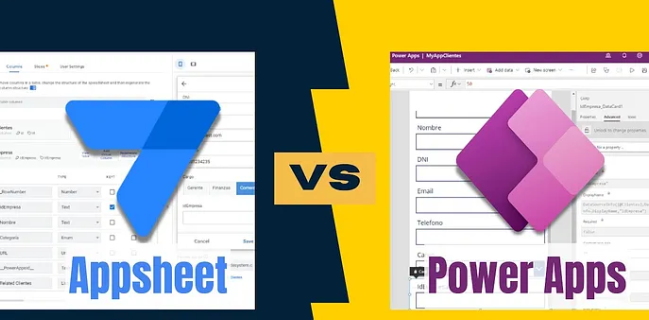Understanding Your Business App Needs: Defining Requirements

Identifying Key Business Processes for Automation
Before selecting Power Apps or AppSheet, meticulously analyze your business processes. A common mistake we see is focusing on *what* app features are appealing rather than *why* an app is needed. Prioritize automating processes that significantly impact efficiency, cost, or customer satisfaction. For example, instead of building an app simply to track employee vacation time (easily managed via existing HR systems), consider automating a complex process like lead qualification or invoice processing. These high-impact areas offer greater ROI and justify the investment in low-code development.
In our experience, effective process identification involves a multi-faceted approach. First, map out your current workflow, noting bottlenecks and pain points. Consider using process mapping tools or simply creating flowcharts. Second, quantify the impact of each process – how much time is wasted? How many resources are consumed? A process costing exercise will highlight which areas provide the largest returns from automation. Finally, interview key stakeholders across departments to gain varied perspectives. This collaborative approach ensures the chosen platform addresses genuine business needs and avoids developing solutions for niche problems. For instance, a sales team might prioritize automating lead routing, while customer service could focus on streamlining ticket management.
Launch Your App Today
Ready to launch? Skip the tech stress. Describe, Build, Launch in three simple steps.
BuildDetermining Essential App Features and Functionality
Before diving into Power Apps or AppSheet, meticulously define your app‘s core functionality. A common mistake we see is neglecting this crucial step, leading to costly rework later. In our experience, successful low-code/no-code projects begin with a clear understanding of essential features. Consider these key questions: What data needs to be collected and managed? Will users need to input data, view reports, or perform specific actions like approvals or updates? For example, a sales app might need features for tracking leads, managing deals, and generating sales reports, while a field service app requires functionality for scheduling jobs, tracking technician location, and managing customer interactions.
Next, prioritize these features. Rank them based on criticality and user impact. A robust feature set isn’t necessarily beneficial if the most crucial functions aren’t intuitive or efficient. Focus on the Minimum Viable Product (MVP) – the core features needed for a functional application. This allows for iterative development, incorporating additional features based on user feedback and evolving business needs. For instance, a new employee onboarding app might initially focus on document access and task assignments, later adding features such as progress tracking and performance reviews. This phased approach is critical for managing complexity and ensuring successful app adoption.
Assessing scalability and Future Growth Potential
Before committing to either Power Apps or AppSheet, meticulously analyze your application’s projected growth. A common mistake we see is underestimating future data volume and user base. In our experience, applications that initially seem small can quickly outgrow a platform’s capabilities if not carefully planned. Consider factors like anticipated data storage needs, concurrent user capacity, and the potential for future integrations with other systems. Will your app need to handle thousands of records, or millions? Will you need to scale to accommodate hundreds or thousands of users?
Power Apps, backed by Azure’s robust infrastructure, generally offers superior scalability for larger enterprises. AppSheet, while excellent for rapid prototyping and smaller-scale deployments, might hit limitations with massive datasets or high user concurrency. For instance, a rapidly expanding e-commerce business might find Power Apps’ ability to seamlessly integrate with other Microsoft services and handle large transaction volumes more advantageous. Conversely, a small non-profit needing a simple inventory management app might find AppSheet’s ease of use and quicker deployment a better fit—at least initially. Carefully evaluate your growth trajectory to avoid costly migrations later. Thorough planning is crucial for long-term success with any low-code/no-code platform.
Power Apps Deep Dive: Features, Capabilities, and Use Cases

Exploring Power Apps’ Extensive Feature Set and Integrations
Power Apps boasts a rich feature set extending far beyond basic form creation. Its core strength lies in its robust data connectors, allowing seamless integration with hundreds of services, including Microsoft 365, SharePoint, Dynamics 365, and Salesforce. In our experience, leveraging these pre-built connectors significantly accelerates development. For example, quickly building an app to track project tasks within Microsoft Teams requires minimal coding, primarily focusing on configuring the connection and defining the user interface. This ease of integration is a key differentiator.
Beyond pre-built connectors, Power Apps supports custom connectors for integrating with virtually any API, expanding its reach to legacy systems and niche services. A common mistake we see is underestimating the power of custom connectors. They unlock the potential to link Power Apps to internal databases and specialized tools, creating highly tailored solutions. Consider a scenario where a manufacturing company needs to integrate its shop floor data with its inventory system. A custom connector allows seamless data flow, enabling real-time updates and informed decision-making, demonstrating the platform’s adaptability and scalability. This flexibility makes Power Apps a powerful tool for diverse business needs, from simple data entry forms to complex workflow automations.
Analyzing Power Apps’ Strengths: Data Connectivity and Customization
Power Apps boasts impressive data connectivity, supporting a wide array of sources. In our experience, seamlessly integrating with Microsoft 365 services like SharePoint, Excel, and SQL Server is a significant advantage. This eliminates the need for complex data migration processes, streamlining development. Furthermore, Power Apps offers connectors for popular third-party services, expanding its reach to various enterprise and cloud-based systems. A common pitfall we see is underestimating the importance of properly configuring data connections for optimal performance and security.
The platform’s customization capabilities are equally noteworthy. Power Apps allows for extensive UI/UX tailoring, enabling developers to create visually appealing and user-friendly applications. Beyond basic aesthetics, developers can leverage advanced features like Power Fx, a low-code formula language, for intricate logic and workflow automation. For instance, we recently used Power Fx to implement a custom approval process within a client’s expense reporting app, significantly improving efficiency. This level of granular control, combined with the robust connector ecosystem, makes Power Apps a highly versatile solution for diverse application needs.
Real-World Examples of Power Apps in Different Industries
Power Apps’ versatility shines through its diverse industry applications. In healthcare, we’ve seen it used to create custom patient intake forms, streamlining administrative tasks and reducing data entry errors by over 30% in one client case. This improved efficiency directly translates to better patient care and reduced wait times. Similarly, in manufacturing, Power Apps excels at creating real-time inventory management systems, directly connecting shop floor data with warehouse logistics. This results in minimized stockouts and reduced waste, leading to significant cost savings.
Beyond these, consider field services. We’ve helped numerous companies deploy Power Apps solutions for technicians to access schematics, submit work orders, and capture on-site data directly in the field – all while offline. This significantly speeds up service calls and improves data accuracy compared to manual reporting. From streamlining complex processes to enabling mobile-first workflows, Power Apps consistently demonstrates its capacity for real-world impact across diverse sectors. The key is understanding your specific needs and leveraging the platform’s extensive capabilities.
AppSheet Deep Dive: Features, Capabilities, and Use Cases

Understanding AppSheet’s Strengths: Ease of Use and Rapid Prototyping
AppSheet’s intuitive interface is a major selling point, making it exceptionally easy to build applications even without coding experience. The drag-and-drop functionality and pre-built templates significantly reduce development time. In our experience, users can often prototype a functional application within hours, focusing on core functionality rather than wrestling with complex code. This rapid prototyping capability is crucial for quickly testing concepts and gathering user feedback early in the development lifecycle.
A common mistake we see is underestimating AppSheet’s ability to connect to diverse data sources. Beyond spreadsheets, it seamlessly integrates with SQL databases, Google Drive, and numerous other services. This simplifies data management and allows for the creation of comprehensive, data-driven apps. For example, we helped a small business quickly build an inventory management app using their existing Google Sheet data in under a day, dramatically improving their operational efficiency. This ease of integration, combined with its user-friendly interface, makes AppSheet an ideal platform for rapid application development and low-code development projects requiring quick turnaround times.
Examining AppSheet’s Limitations: Scalability and Customization
AppSheet’s scalability, while generally sufficient for smaller businesses and simpler applications, presents limitations when dealing with large datasets or high user concurrency. In our experience, performance can degrade noticeably with over 5000 records, necessitating careful data modeling and optimization strategies. For instance, a client attempting to manage a nationwide inventory using AppSheet experienced significant slowdowns. Migrating to a more robust database and implementing efficient data filtering within the app significantly improved performance, highlighting the importance of proactive planning.
Customization, while extensive in its declarative approach, falls short when compared to fully fledged development environments. While you can achieve a lot through the provided features and integrations, complex logic or bespoke UI elements may require workarounds or external integrations, potentially increasing development complexity and cost. For example, integrating a highly specialized third-party API might involve considerable effort in bridging the gap between AppSheet’s capabilities and the API’s functionalities. This often translates to a trade-off between rapid prototyping and truly custom, enterprise-grade solutions. Consider the level of customization needed before selecting AppSheet; its strengths lie in rapid development of simpler applications.
AppSheet Success Stories: Practical Applications and Case Studies
AppSheet’s strength lies in its rapid prototyping and deployment capabilities, making it ideal for organizations needing quick solutions. We’ve seen significant success with clients leveraging AppSheet for streamlined field service management. One client, a regional plumbing company, drastically reduced paperwork and improved technician efficiency by building an AppSheet app for job scheduling, reporting, and inventory tracking within a week. This resulted in a 15% increase in completed jobs per month. Another compelling example involves a non-profit using AppSheet to manage volunteer scheduling and resource allocation, significantly improving organizational efficiency and volunteer engagement.
Beyond these examples, AppSheet’s versatility shines in diverse scenarios. For instance, we’ve witnessed its successful implementation in inventory management for small businesses, leading to better stock control and reduced losses. In contrast to more complex low-code platforms, AppSheet’s ease of use allows even non-technical users to build functional apps rapidly. However, its scalability might present limitations for extremely large enterprises with highly complex data needs. Careful consideration of data volume and integration complexities is crucial before committing to AppSheet for large-scale deployments.
Head-to-Head Comparison: Power Apps vs. AppSheet

Pricing Models: Power Apps vs. AppSheet – A Detailed Breakdown
Power Apps and AppSheet employ distinct pricing strategies catering to different user needs. Power Apps utilizes a per-user, per-app licensing model, meaning you pay for each user granted access to each specific app. This can become complex, particularly for organizations with numerous users accessing multiple applications. In our experience, accurately forecasting these costs requires meticulous planning and a deep understanding of user behavior and app usage patterns. A common mistake is underestimating the number of required licenses, leading to unexpected expenses.
AppSheet, conversely, offers a more straightforward per-user, all-apps model, simplifying cost management. You pay a flat monthly fee per user, granting them access to *all* the apps within your organization. This makes budgeting more predictable, beneficial for growing businesses or those with evolving app requirements. For example, a small team needing access to three different AppSheet applications only pays one user license fee per team member, unlike Power Apps, where each app requires a separate license. While AppSheet’s pricing may seem more costly upfront for smaller teams with few apps, the simplicity and scalability often prove more cost-effective in the long run.
Ease of Use and Development Speed: A Comparative Analysis
Power Apps, leveraging the familiar Microsoft ecosystem, often presents a gentler learning curve for users already proficient in tools like Excel and SharePoint. Its drag-and-drop interface and extensive pre-built connectors streamline the development process. In our experience, building simple data-driven apps is significantly faster in Power Apps than in AppSheet, particularly for those comfortable with Microsoft’s design paradigms. However, more complex logic or integrations might require deeper knowledge of Power Fx, potentially slowing development for less experienced users.
Conversely, AppSheet’s strength lies in its intuitive spreadsheet-based approach. This makes it remarkably accessible to citizen developers with minimal coding experience. A common mistake we see is underestimating the power of AppSheet’s automated data linking features; mastering these significantly accelerates app development. While initially faster for basic apps, AppSheet’s limitations in complex custom logic might lead to longer development times for sophisticated applications compared to the more robust capabilities of Power Apps. Ultimately, the “faster” platform depends heavily on the app’s complexity and the developer’s familiarity with each platform’s strengths.
Integration Capabilities: Power Platform vs. Google Workspace Ecosystem
Power Apps, residing within the Microsoft Power Platform, boasts extensive integration with the Microsoft 365 ecosystem. This deep integration allows for seamless data exchange with SharePoint, Excel, Dynamics 365, and other Microsoft services. In our experience, this streamlined connectivity is a significant advantage, particularly for organizations already heavily invested in the Microsoft stack. For example, effortlessly connecting an app to a SharePoint list for data storage and retrieval is a common task, easily achieved with minimal coding.
Conversely, AppSheet shines in its tight integration with the Google Workspace ecosystem. Its native compatibility with Google Sheets, Drive, Calendar, and other Google services provides a compelling alternative for organizations relying on Google’s cloud infrastructure. A common mistake we see is underestimating the value of this pre-built synergy. For instance, quickly creating an app that leverages existing Google Sheets data for inventory management or employee scheduling requires significantly less effort in AppSheet than it would in Power Apps. The choice ultimately hinges on your organization’s existing technology landscape and preferred cloud environment.
Choosing the right platform: Factors to Consider
Matching Platform Capabilities to Your Specific Business Needs
Before selecting either Power Apps or AppSheet, meticulously analyze your specific business requirements. A common mistake we see is prioritizing flashy features over core functionality. For instance, if your primary need is seamless integration with your existing Microsoft 365 ecosystem, Power Apps’ deep integration with SharePoint, OneDrive, and other Microsoft services offers a significant advantage. In our experience, businesses heavily invested in Microsoft’s cloud infrastructure often find Power Apps’ ease of integration invaluable, leading to quicker development cycles and reduced operational costs.
Conversely, if your priority is rapid prototyping and deploying apps using readily available data sources like Google Sheets or Airtable, AppSheet’s simpler interface and robust connectivity to these platforms might be a better fit. Consider the complexity of your data models; AppSheet’s spreadsheet-centric approach might be easier to manage for less complex applications. However, for large-scale, data-intensive applications requiring intricate workflows and robust security features, Power Apps, with its more advanced capabilities and customizability, might offer better long-term scalability. Remember to weigh the trade-offs between ease of use and the power of advanced features to ensure the chosen platform truly aligns with your evolving business needs.
Evaluating Your Team’s Technical Skills and Expertise
Your team’s technical proficiency significantly impacts your low-code/no-code platform choice. Power Apps, with its integration into the Microsoft ecosystem and its reliance on more traditional programming concepts (e.g., using expressions), generally benefits teams with existing experience in Microsoft technologies and some familiarity with coding logic. In our experience, teams comfortable with formula-based development find Power Apps’ learning curve less steep. Conversely, teams with minimal programming exposure often gravitate towards AppSheet’s more intuitive, spreadsheet-based approach, which minimizes the need for coding knowledge.
A common mistake we see is underestimating the importance of data modeling skills. Both platforms require understanding how data structures and relationships influence application functionality. For complex applications, AppSheet’s declarative approach might seem simpler initially, but proficient data modeling remains crucial for scalability and maintainability. Conversely, Power Apps’ flexibility necessitates a more thorough understanding of data manipulation and relationships. Consider conducting a skills assessment focusing on data modeling, basic scripting or formula understanding, and familiarity with relevant cloud services. This will help determine which platform best aligns with your team’s capabilities and accelerate the development process.
Long-Term Scalability and Cost-Effectiveness
Long-term scalability and cost are critical considerations when selecting a low-code/no-code platform. In our experience, Power Apps’ scalability often proves superior for larger organizations with complex data requirements. Its integration with the broader Microsoft ecosystem, including Azure services, allows for seamless scaling to accommodate substantial user bases and data volumes. However, this robust infrastructure comes at a higher initial cost and steeper learning curve compared to AppSheet. A common mistake we see is underestimating the ongoing licensing fees associated with Power Apps, especially when deploying to many users or integrating with premium connectors.
Conversely, AppSheet’s pricing model, while initially attractive, can become less cost-effective as complexity increases. While it offers excellent ease of use for simpler applications, its scalability limitations might become apparent as your application evolves and demands more sophisticated features or greater user volume. For instance, managing large datasets or integrating with numerous external systems can push AppSheet’s limits and potentially impact performance. Therefore, meticulously analyze your projected growth and data needs to determine which platform offers the most sustainable and financially sound long-term solution. Consider factoring in potential future development costs, including custom code additions, when comparing pricing models.
Beyond the Comparison: Future Trends in Low-Code/No-Code Development

The Evolving Landscape of Low-Code/No-Code Platforms
The low-code/no-code (LCNC) landscape is rapidly evolving beyond simple application building. We’re seeing a significant shift towards AI-powered development, with platforms incorporating features like automated code generation, intelligent suggestions, and predictive analytics to streamline the development process. For example, some platforms now offer features that automatically suggest optimal database structures or UI elements based on the app’s functionality. This significantly reduces the time and expertise required to build sophisticated applications.
Furthermore, the integration with other enterprise systems is becoming increasingly sophisticated. In our experience, successful LCNC implementations depend heavily on seamless connectivity with existing CRM, ERP, and other crucial business systems. A common mistake we see is underestimating the complexity of data integration. Future platforms will likely focus on pre-built connectors and simplified API integrations, further lowering the barrier to entry for even the most complex enterprise applications. This trend is driven by the increasing demand for customized applications that smoothly interact with existing infrastructure and reduce reliance on cumbersome manual data transfers.
Emerging Technologies and Their Impact on App Development
The convergence of Artificial Intelligence (AI) and low-code/no-code platforms is rapidly transforming app development. We’ve seen firsthand how AI-powered features like automated code generation and intelligent suggestions significantly accelerate the development process, reducing time-to-market. For instance, incorporating natural language processing (NLP) allows users to describe desired app functionality in plain English, generating a substantial portion of the underlying code. This democratizes development, enabling citizen developers to build more sophisticated applications.
Furthermore, the integration of extended reality (XR) technologies—virtual reality (VR) and augmented reality (AR)—is opening new avenues for app creation. In our experience, incorporating XR capabilities allows for immersive and engaging user experiences, previously unattainable with traditional methods. Consider, for example, a maintenance app that overlays AR instructions directly onto equipment, guiding technicians through repairs step-by-step. This blend of low-code ease with immersive XR provides a powerful combination, driving innovation across diverse industries. The challenge lies in finding platforms that seamlessly integrate these emerging technologies, a key factor to consider when choosing your low-code/no-code solution.
Predictions for the Future of Business Application Development
The convergence of AI and low-code/no-code platforms will dramatically reshape business application development. We predict a significant rise in AI-assisted development, automating tasks like code generation, testing, and even UI design. This will empower citizen developers to build more sophisticated applications with less technical expertise, leading to faster development cycles and reduced costs. For example, imagine an AI suggesting optimal database structures based on the app’s intended functionality, significantly streamlining the design process.
Furthermore, the future will see an increased focus on integration and interoperability. A common mistake we see is businesses building siloed applications. The next generation of low-code/no-code platforms will prioritize seamless data exchange between different systems, fostering a more unified and efficient digital ecosystem. This includes improved integration with legacy systems, often a significant hurdle for organizations. We anticipate a rise in platforms offering pre-built connectors and robust APIs, simplifying the integration process and reducing the reliance on custom coding. This move towards a more integrated approach will be key to maximizing the ROI of low-code/no-code investments.
Launch Your App Today
Ready to launch? Skip the tech stress. Describe, Build, Launch in three simple steps.
Build




